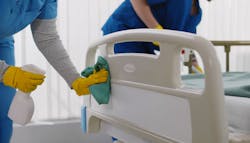Infection prevention battle plan: Time to go to the mattresses
For a product and process that occupies a significant portion of our lives (roughly a third), not nearly enough effort and time is being dedicated to maintaining beds and mattresses used in healthcare facilities for patient recovery and rest.
Experts point to a number of roadblocks and speedbumps complicating the maintenance of beds and mattresses, which includes cleaning, disinfecting, sterilizing, repairing and even replacing the products when necessary. Reasons span a lack of manufacturers’ instructions for use (MIFUs) – both for the reprocessing products and for the material compatibility of beds and mattresses on which they are used – as well as the lack of following the MIFUs they may have in place already. Reasons also span awareness of any problems, shortcomings of the manual technique used to spot potential problems as well as the raw materials used to make the beds and mattresses and whether the reprocessing agents used to kill infectious microorganisms may also harm the structural materials of the beds and mattresses.
Experts recognize that the manual technique used to spot potential problems relies on the “visual method” or what you can see. Coupled with pressure to return a room to high-quality hygienic status may mean you miss the gouges scrapes along bed decks and rails that can harbor hard-to-reach microorganisms or the fluid that soaked through surface cracks and punctures in the mattress, leading to mold germinating in the foam core.
One of the leading authorities in bed and mattress sterility, who has published detailed research studies in the clinical journals for years and who spoke about his work during an HPN Online Forum two years ago, acknowledges that the challenges remain.
1. Lack of efficacy of cleaning disinfection processes used by most hospitals
“Mattresses are medical devices,” Hooker said. “Although mattresses used to be made of a very tough vinyl, today, most acute care mattresses are made of a polyurethane-coated fabric, which makes them a soft/porous surface. Single-step cleaning and disinfection processes using hard surface disinfectants are not recommended by mattress manufacturers because they don’t work and they destroy the mattress cover. Although many hospitals use one-step cleaner/disinfectants on healthcare mattresses, they are not approved for this use.
“The manufacturer’s instructions for cleaning and disinfection of mattresses require many distinct steps: Pre-cleaning (removing obvious soil), cleaning, rinsing off the cleaner with water, disinfecting, rinsing off the disinfectant and inspecting the mattress for damage,” he continued. “In a previous survey of infection control nurses, we showed that most hospitals use one-step processes, do not perform routine inspections, and have experienced mattress failures with patient exposure to blood and body fluids.”
2. Complex MIFUs that require multiple steps are not practical in a high-turnover environment and requires significant staff training and oversight.
“The manufacturer’s instructions for use require the multistep process that is difficult to remember and takes around 45 minutes to perform on just the mattress and bed frame,” Hooker indicated. “Training environmental services personnel and ensuring that they have performed adequate cleaning is difficult. Also, hospitals need rooms turned over quickly, which does not give EVS personnel time to do perform adequate cleaning.”
3. Non-fluid proof seams
“Many healthcare mattresses have sewn zipper seams that create 3,000 holes around the perimeter of the mattress surface, allowing fluids to leak into the mattress,” he warned.
4. Mattresses that cannot be opened
“Although many mattresses have zippers to allow for routine inspection of the inside for damage, most hospitals fail to routinely open these mattresses and inspect them,” Hooker noted. “Some mattresses, especially those used in operating rooms and emergency departments, cannot be opened and inspected for damage and contamination. This allows contaminated mattresses to remain in use, which is a clear and present danger to patients.”
“We are trying to deal with a microbial issue at a macro level,” she observed. “We cannot see microbes, yet we assume that a mattress is clean and not damaged based on a visual inspection. When we see the damage, microbes have already penetrated the surface. Not only is the outside of the mattress cover potentially harboring pathogens the mattress’s core may as well. Pathogens may be released from the inner core when someone lays and moves on the mattress. There have been reports of moisture seeping up from the inside of the mattress through seams and damaged outer surface.”
Watch for covert vs. overt effects
“No patient should ever experience getting wet from a patient mattress,” he said. “Patients deserve better and should not be exposed to biohazardous material ever, let alone in their most vulnerable state.”
Much depends on the cleaning/disinfecting products used on the beds and mattresses.
“A variety of cleaners/disinfectants exist in the marketplace, giving end users a great deal of options for addressing sources of hospital-acquired infections,” Rotter continued. “Most of these products, however, are not sporicidal and provide no efficacy against spore-forming bacteria. Generally, end users must rely on oxidative chemistry for this level of efficacy, but manufacturers rarely recommend such chemistry for routine use, if at all, on their equipment. End users with no options must either adopt their infection control protocol of proactively using sporicidal chemistries, sometimes going against manufacturer instructions, or not use sporicidal products and risk addressing potential sources of hospital acquired infections.”
“Minimal cracks and crevices can harbor hard to reach microorganisms,” Mathieson indicated. “The differential of cleaning products and a system’s ability to acknowledge that changes may be made to cleaning protocol is an issue that has been popping up occasionally. However, with hospitals adhering to new auditing guidelines being set by governing organizations, we are seeing a decline on issues related to this.
“Disinfection is the process of eliminating or reducing harmful microorganisms from the surfaces, while sterilization is the process of killing all microorganisms,” she continued. “End users can also tell the difference by adhering to the wet contact time needed to eliminate the stated pathogens of a cleaner. Oftentimes, the customer may not actually be keeping a surface wet enough or using enough wipes/solution to achieve the attended kill. We see The Joint Commission prompting audit guidelines to incorporate more stringent cleaning protocols.”
“Most common physical damage is caused by punctures, tears and abrasions, which if left undetected, overlooked or improperly repaired, lead to serious cross contamination risks for current patients, incoming patients and staff,” he said. “Damaged soft surfaces can never be properly cleaned regardless of how good your CDP is. When the integrity of a mattress cover is compromised the there is always a high risk of occult damage occurring from fluid ingress of blood and body fluids.”
Thanks to the Clean Bed Initiative (CBI) at Cone Health, clinicians and administrators underwent a great awakening to the need for proper bed and mattress decontamination, according to James B. Waddell, BLS, ICRA, CSCMP, SW Patient Care Support Manager, Nursing Administration. (For more details on Cone Health’s CBI, read the story here.)
“One of the main issues identified was that repair technicians often discovered that downed beds were delivered and not properly cleaned,” he said. “Our [CBI] work group discovered that receiving departments (patient care or repair) trusted that beds came already cleaned and disinfected. However, it was an ‘aha moment,’ finding that was not always the case. This became a highlighted standard work point of focus.”
What should manufacturers do?
Experts believe manufacturers can help improve this process in several ways but stop short of placing blame or pointing fingers at anyone.
Proper bed and mattress maintenance generates hygienic and economic benefits, according to Surface Medical’s Lam.
“Manufacturers should place greater emphasis on the importance of equipment maintenance to protect the health and safety of vulnerable patients,” he noted. “Because hospital mattress covers are one of the highest touchpoints in the patient environment, comprehensive cleaning practices are essential to reduce the spread of dangerous pathogens to patients and staff. Hospital mattress covers must be maintained in an intact state to be effectively cleaned, so manufacturing guidelines should reinforce the importance of frequent mattress cover inspection for signs of damage. Clear and focused messaging from manufacturers on the importance of maintaining equipment in good working condition, would support infection prevention protocols that address cleaning, disinfecting, sterilizing, and repair of mattresses.
“Because the immediate replacement of damaged hospital mattresses is not always logistically or economically feasible, surface repair with an approved product enables healthcare facilities greater control over the timing of equipment replacement, while ensuring that the mattress surface can be safely used by patients,” Lam added.
Ecolab’s Rotter acknowledges that manufactures emphasize proper care and maintenance for beds and mattresses but recognizes that more could be done.
“Most bed and mattress manufacturers provide a great deal of emphasis on the cleaning and disinfection process of equipment surfaces including cautionary language against practices, procedures or use of products that might adversely affect the equipment,” he said. “Manufacturers should continue to try to improve upon these instructions, so they are clear and cover comprehensively the various types of cleaning/disinfecting agents available in the marketplace that are either suitable or contraindicated. Unfortunately, end users can be left confused when specific classes of ingredients or actives in disinfectant cleaners are neither recommended nor contraindicated in manufacturer’s instructions for use.”
Rotter admits the difficulty hospital staffers may face here, which is why manufacturers should step up.
“Mattresses are challenging to inspect with failure of the moisture barrier commonly only being noticed after fluid ingress,” he noted. “Manufacturers should stress the importance of routine inspection and how to properly inspect the equipment for signs of needing repair or service. Products showing any sign of degradation should be removed from service.”
Manufacturers must keep customers front of mind when they release products and IFUs, according to Stryker’s Mathieson.
“Manufacturers should provide clear and in-depth information on cleaning protocols and accepted chemicals/products that can be used for cleaning/disinfecting/sterilizing and repair when making a sale,” she indicated. “We believe in transparency and ease of use for our customers, and that includes how to take care of our products.
“Our customers motivate us to make cleaning/disinfecting/sterilizing/repair instructions and protocols clear,” Mathieson continued. “Through our partnership with customers, we’ve found that operations manuals are not always as straightforward as one may think for busy staff. We go beyond ‘good enough’ by creating cleaning videos that showcase best practices when taking proper care of our products. The customers should be at the forefront of all manufacturers motivation to provide quality products and information – maintenance being one of them.”
Medtrica’s Willoughby contends that content is king.
“Manufacturers should always provide very detailed IFU for the proper storage, use and maintenance of the mattress – cover and core,” he insisted. “However, these recommendations are not designed to replace cleaning and disinfection protocols implemented and managed by infection control and/or the hygiene officer of the hospital overseeing soft-surface infection prevention.”
Xavier University’s Hooker places great value on manufacturer IFUs making a difference.
“The hospital bed and mattress manufacturers need to emphasize the importance of hospital personnel following the MIFUs every time they clean (reprocess) the bed and mattress for the next patient,” he emphasized. “The salespeople do not explain the importance of proper reprocessing not only for patient protection [but also] to extend the life of the bed/mattress. Most hospitals incorrectly assume that they can use a one-step cleaning processing, which is simply inadequate. Also, The Joint Commission requires hospitals to follow the MIFUs.”
Hooker further notes that “newer MIFUs have been required by the FDA Reprocessing Guidance for Reusable Medical Devices since 2015. Per the FDA Guidance the process must have established efficacy against key organisms, including myco-bacteria, state a process to achieve those results as well as the expected life of the device (outer mattress cover) using those processes.”
Lybert from Health Surfaces Institute urges that maintenance issues logically be explored at the very beginning.
“Of all medical devices the bed is what the patient has the most contact with,” she noted. “Cleaning and disinfection should be one of the top three most important design features and should be evaluated with a team of Infection Preventionists and Environmental Services professionals before design. These are the professionals who will be responsible for cleaning and disinfection to ensure the bed is safe for the next patient. Understanding that there are time constraints often imposed during room turnover times and during daily cleaning, it is important to consider that during design.”
Cone’s Waddell requires emphasis on this always to be high.
“It’s important to keep all equipment clean and fully functional, especially when it comes to the safety of everyone involved, including patients, repair techs and transporters,” he said. “Depending on the acuity of a patient, a bed could potentially be a single touchpoint of every aspect of hospital operations.”
About the Author
Rick Dana Barlow
Senior Editor
Rick Dana Barlow is Senior Editor for Healthcare Purchasing News, an Endeavor Business Media publication. He can be reached at [email protected].







